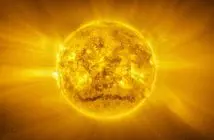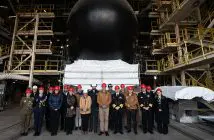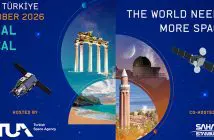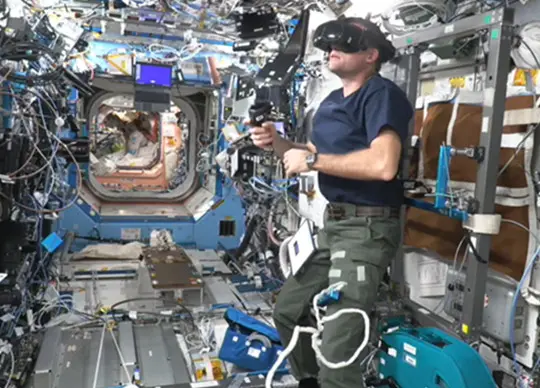
Following the deployment of a VIVE Focus 3 onboard the International Space Station (ISS) to support with mental health, the mission has expanded to include physical health.
Now the VIVE Focus 3 is being used as part of vital exercise routines. The European Space Agency’s Andreas Mogensen, Commander of the ISS for the duration of his six-month mission, has been using a FERGO exercise bike and VR experience built by the Danish Aerospace Company.
To combat the sterile and bland interior of the ISS, Andreas wears a VIVE Focus 3 and has a visually and physically matched experience when cycling now. As he cycles, the scenery moves in time, and the VIVE Focus 3 sends information via Bluetooth to FERGO, which provides resistance as he cycles uphill or on different surfaces. In the VR experience there are five different cycling routes for Andreas to enjoy, filmed in his native Denmark: Loekken, Silkeborg, Svanninge Bakker, Odense Aasti, and by the Copenhagen Lakes.
One particularly challenging scenario was contributed by 10-year-old Isabella Dam from Saltum, a competition winner in Denmark, who shared footage of her cycling on Loekken beach, with unique views including the World War II bunkers.
Experts like Jeremy Curtis from the UK Space Agency, have said that astronauts in space for five months can lose up to ‘40% of muscle and 12% of bone mass’, and that “… the muscle loss is the equivalent of a 20-year-old turning into a 60-year-old over a period of three months.” Upon returning to Earth, some astronauts have spent up to 12 months in physical rehabilitation to regain full fitness. While in space they must exercise for two hours every day just to try and minimise the effects of microgravity.
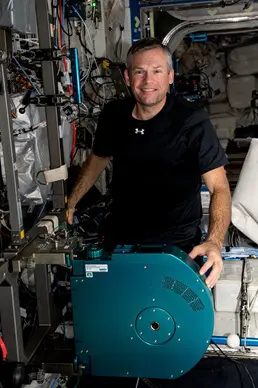
Andreas is an ambassador of the WILD Nature Foundation, and speaking to them on 17 January 2024 he said, “I miss the earth. I do. It’s a beautiful sight to sit in the Cupola and look down on Our Blue Planet, but it’s not the same. I miss the feeling of the warm sun. I miss the breeze. I miss the smell of the grass and the trees. I just miss opening a door and stepping outside – I do yes, and the sound of nature. It’s a very very unnatural laboratory we’re in. One of the experiments I have here is a virtual reality set I use to refresh myself to help my psyche, and it’s actually wonderful. One of the things I love about this virtual reality set, is the sound, hearing the sound of the birds chirping, hearing the sound of the wind blowing through the reeds and through the leaves. I love that and it’s something I miss.”
“The deployment of VIVE Focus 3 on the ISS for mental health was an incredible milestone, and we’re excited to build on this success by expanding the initiative to include support for astronaut physical health,” said Cher Wang, Chairwoman and Co-Founder of HTC. “At HTC, we’re driven by a culture of innovation and we’re constantly seeking out new ways to push cutting-edge immersive technology to benefit humanity. VIVE Focus 3 being the first standalone VR/XR headset to work in the microgravity conditions of space is a testament to our team’s efforts, and will have a great impact on Earth and beyond.”
Thomas A.E. Andersen, CEO, Danish Aerospace Company, “Supporting physical health of astronauts in microgravity is critical, not just for the success of a mission but for long-term health, and it actually helps with mental health as well. Our first exercise bike, CEVIS, functioned for over 20 years on the ISS and gave us a lot of insights. FERGO is a great upgrade, and combining it with VIVE’s VR expertise means that astronauts can be more engaged with exercise and hopefully also more motivated.”
Per Lundahl Thomsen, CTO, Nord-Space ApS, “The physical challenges of living in a low gravity environment cannot be underestimated, with astronauts experiencing loss of muscle mass and bone density. Nord-Space ApS is proud to have supported VIVE’s development to get VR working in microgravity, because we’ve now been able to make a real and measurable positive difference in the lives of astronauts on the International Space Station.”
The International Space Station is a challenging environment, because while there’s the beauty of Earth and the vast majesty of space, the ISS itself is small, confined, noisy, and visually sterile. A previous ESA mission filmed a tour: Grand tour of the International Space Station with Drew and Luca | Single take (youtube.com).


